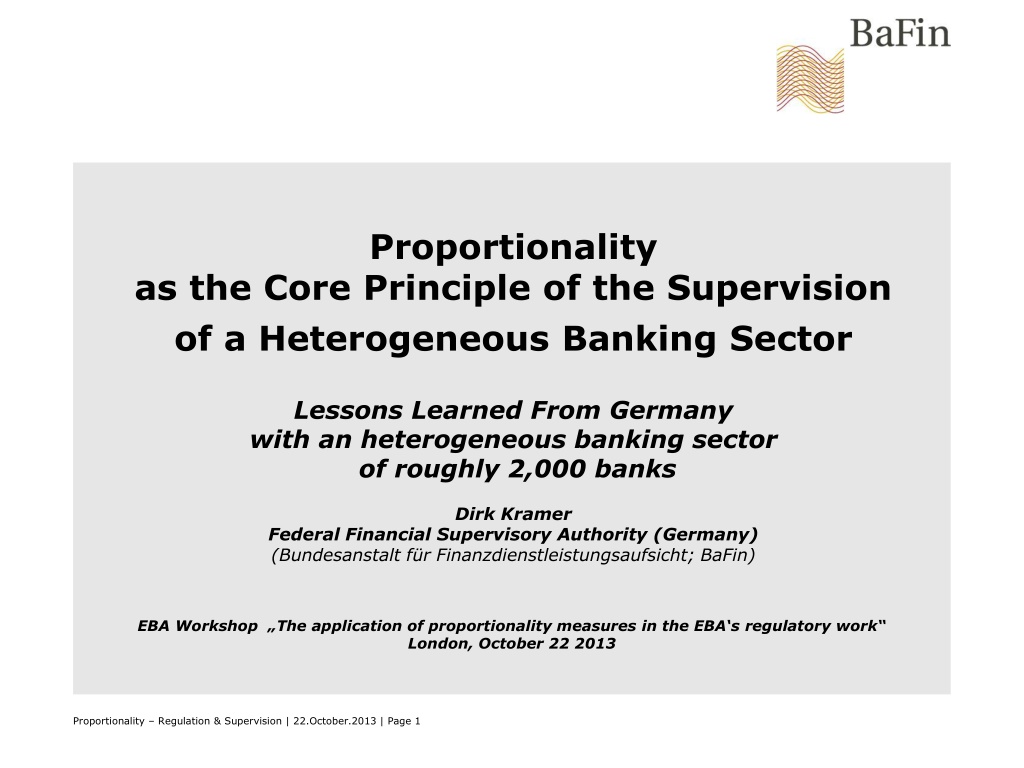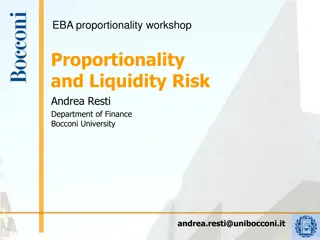Proportionality as Core Principle in Supervising Heterogeneous Banking Sectors: Lessons from Germany
The supervision of a diverse banking sector, such as Germany's with roughly 2,000 banks, is based on the core principle of proportionality. This approach involves tailoring regulations and oversight to fit the individual characteristics of each institution, focusing on qualitative aspects, organizational structures, and risk management. The concept advocates for a principle-based regulation with a broad scope and flexibility in implementation, as seen through initiatives like the Minimum Requirements for Risk Management (MaRisk).
Download Presentation

Please find below an Image/Link to download the presentation.
The content on the website is provided AS IS for your information and personal use only. It may not be sold, licensed, or shared on other websites without obtaining consent from the author. Download presentation by click this link. If you encounter any issues during the download, it is possible that the publisher has removed the file from their server.
E N D
Presentation Transcript
Proportionality as the Core Principle of the Supervision of a Heterogeneous Banking Sector Lessons Learned From Germany with an heterogeneous banking sector of roughly 2,000 banks Dirk Kramer Federal Financial Supervisory Authority (Germany) (Bundesanstalt f r Finanzdienstleistungsaufsicht; BaFin) EBA Workshop The application of proportionality measures in the EBA s regulatory work London, October 22 2013 Proportionality Regulation & Supervision | 22.October.2013 | Page 1
Proportionality / Regulation & Supervision (I) Background Heterogeneity of the German financial system (roughly 2,000 institutions varying by size, complexity, business model, etc.) Our understanding of Pillar 2 requirements Qualitative proportional requirements Focus on organisational structures & processes Recognition as a management tool for banks Long-term experience with qualitative supervision Proportionality Regulation & Supervision | 22.October.2013 | Page 2
Proportionality / Regulation & Supervision (II) Concept of Proportionality within Pillar 2 regulation & supervision Can we precisely (and practically) define proportionality? Do we need clear-cut thresholds resulting in automatism? appealing but have their drawbacks Alternative concept: principle based regulation with a basic rulebook Wide scope: for all credit institutions and investment firms Comprehensive: addresses main risk management issues (requires only few further regulations/guidelines) Banks are responsible for the implementation depending on nature, scale and complexity of the banks and their activities In Germany: the Minimum Requirements for Risk Management (MaRisk) EBA GL 44 + few further issues Proportionality Regulation & Supervision | 22.October.2013 | Page 3
Categorisation & On-site Inspections in 2012 Source: BaFin. Annual Report 2012 (Table 19/p. 141) Proportionality Regulation & Supervision | 22.October.2013 | Page 4
Our Recommendation We should further elaborate the EBA Guidelines on Internal Governance (GL 44) as the central basis of Pillar 2 requirements within the European Single Rule Book! More granularity (not rule based) A flexible guideline for categorisation with case-by-case decisions Integrate other guidelines, i.e. increasing the scope Proportionality Regulation & Supervision | 22.October.2013 | Page 5
Thank you very much for you attention Dirk Kramer Dirk.Kramer@bafin.de (Section BA 54: BA54@bafin.de) Proportionality Regulation & Supervision | 22.October.2013 | Page 6
Appendix I: Supervision Pyramid Final responsibility for prudential supervision by BaFin, in close cooperation with Deutsche Bundesbank Off-site supervision by using various information sources for daily supervision and risk assessment; including the auditors long form report as a central element special audits (sect. 44 Banking Act) by Deutsche Bundesbank and external auditors Internal controls and risk management of the institutions It is the task of supervisors to challenge institutions on a case-by-case basis to implement the requirements with MaRisk as the benchmark. Proportionality Regulation & Supervision | 22.October.2013 | Page 7
Appendix II: Modular Structure of MaRisk General Requirements Issues such as: internal capital adequacy process (ICAAP), risk-inventory, strategies, documentation, stress testing, human- and technical resources, outsourcing, activities in new products/markets, Special Requirements for the Internal Control System Requirements for the structural and operational arrangements Requirements for processes for risk control: Liquidity risk Market price risk Lending business Trading business Counterparty risk Operational risk Special Requirements for the Internal Auditing Function Proportionality Regulation & Supervision | 22.October.2013 | Page 8























